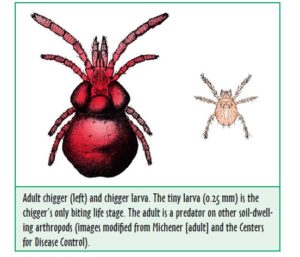 What Exactly Are Chiggers?
What Exactly Are Chiggers?
Chiggers are the first stage out of the egg of a particular type of mite. They climb onto people and other animals walking through infested areas, crawl upwards, and wander around the body seeking a good site to settle down and feed. Feeding preference for these mites on humans is in areas where skin is thinnest (behind knees, armpits) or where clothing fits tightly, such as the ankles, waist, and the groin area.
What Causes All That Itching?
Chiggers do not burrow into skin as many people believe, so “smothering” them with nail polish is useless. When chiggers feed, they inject a digestive enzyme that breaks down skin cells. The skin cells then create a feeding tube called a stylostome that the chigger uses to suck up liquified skin cells to eat. Itching and redness is caused when our body reacts to the enzymes injected into our skin as well as the body breaking down the stylostome. Itching typically begins 3-6 hours after being bitten, peaks at 24 hours, and can last up to two weeks. By the time you begin to itch from chiggers, they are usually long gone as they will fall off the body once feeding is completed or can be brushed off by clothing or showering.
How to Avoid Chiggers
The best way to avoid getting chiggers is to avoid infested areas. Since this is not always possible, here are some other things to try:
- Wear protective clothing- tightly woven items that fit loosely; including long sleeves & pants; shoes or boots
- Tuck pant legs into socks and boots
- Use an insect repellent with DEET or picaridin before entering an infested area
- Avoid sitting on the ground
- Remove & launder clothing ASAP after being in infested areas
- Shower/ bathe after being in an infested area; scrub vigorously with a washcloth
How to Treat Infestations
To treat chigger infestations around the home, try the following:
- Keep lawn trimmed
- Maintain vegetation; do not allow weeds to grow up & keep brush cleared
- Target infested areas with residual pesticide sprays
How to Treat Chigger Bites
For chigger bites:
- Do not scratch pustules; opening pustule might lead to infection
- Oral antihistamines or topical anti-itch creams to relieve itching sensation
For more information or help with identification, contact Wizzie Brown, Texas AgriLife Extension Service Program Specialist at 512.854.9600
Additional Resources
Chiggers – Biology, Defense, Treating Bites
Diagnosing Mysterious Bug Bites
About Wizzie

Wizzie Brown
County Extension Program Specialist – Integrated Pest Management
Email:EBrown@ag.tamu.edu
Wizzie has been with Texas A&M AgriLife Extension Service since 2002 and has been playing with insects since she was a toddler. She is an Extension Program Specialist with the Integrated Pest Management (IPM) program. Wizzie holds a B.S. in entomology from The Ohio State University and a M.S. in entomology from Texas A&M University. The integrated pest management program provides identification, biological and management information to whomever needs help. Wizzie’s research focuses on imported fire ants, including community wide fire ant management. Wizzie also is happy to provide programs to area groups on a variety of arthropod-related topics. You can find insect and other arthropod information on Wizzie’s blog.
